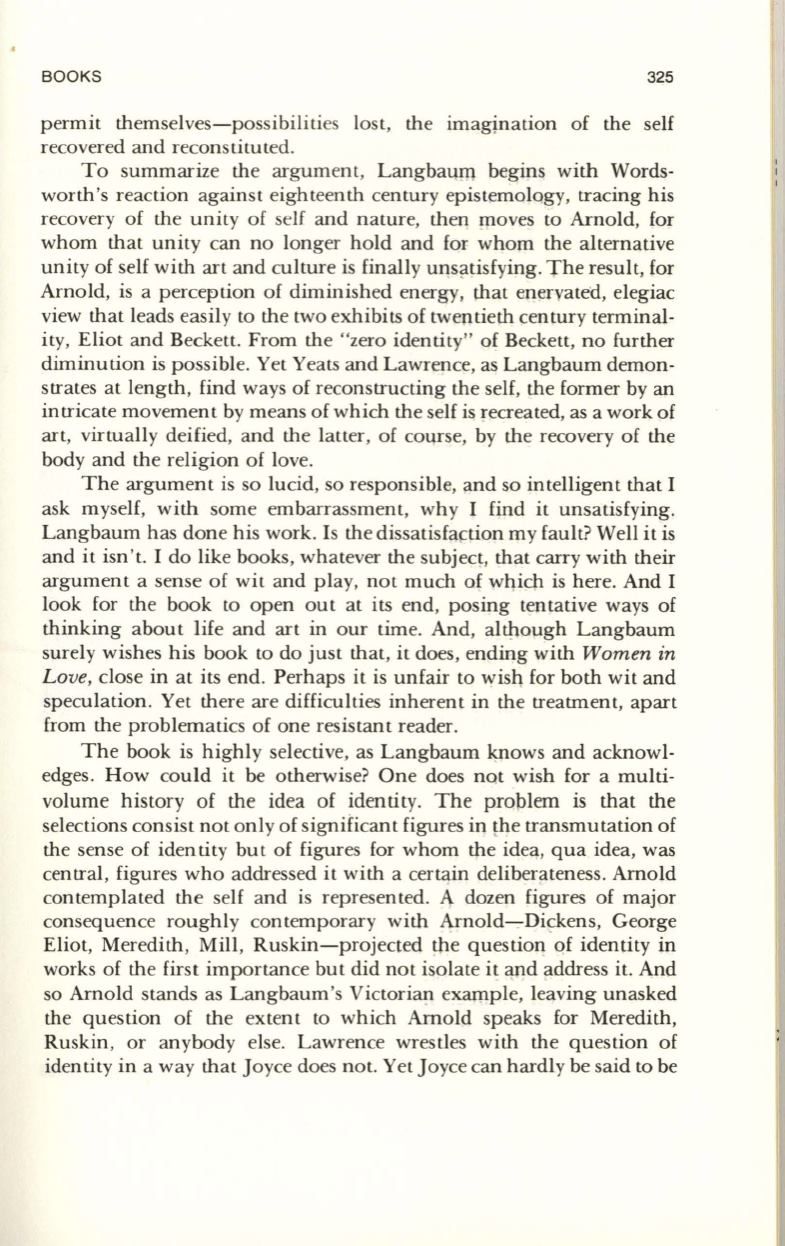
BOOKS
325
permit themselves-possibili ties lost, the imagjnation of the self
recovered and reconstituted.
To summarize the argument, LangbalPTI begins with Words–
worth 's reaction against eighteenth century epistemology, tracing his
recovery of the unity of self and nature, theI1 !lloves to Arnold, for
whom that unity can no longer hold and for whom the alternative
unity of self with art and culture is finally
uI1s~tisfying.
The result, for
Arnold, is a perception of diminished energy, that enervated, elegiac
view that leads easily
to
the two exhibits of twentieth century terminal–
ity, Eliot and Beckett. From the "zero identity" of Beckett, no further
diminution is possible. Yet Yeats and Lawrence, as Langbaum demon–
strates at length, find ways of reconstructing the self, the former by an
intricate movement by means of which the self is recreated, as a work of
art, virtually deified, and the latter, of COllrse, by the recovery of the
body and the religion of love.
The argument is so lucid, so responsible, ;md so intelligent that I
ask myself, with some embarrassment, why I find it unsatisfying.
Langbaum has done his work. Is the
dissatisfa~tion
my fault? Well it is
and it isn't. I do like books, whatever the subjeq, that carry with their
argument a sense of wit and play, not much of wqicp is here. And I
look for the book to open out at its end, posing tentative ways of
thinking about life and art in our time. And, althollgh Langbaum
surely wishes his book to do just that, it does, ending with
Women in
Love,
close in at its end. Perhaps it is unfair to 'Visq for both wit and
speculation. Yet there are difficulties inherent in the treatment, apart
from the problematics of one resistant reader.
The book is highly selective, as Langbaum
~nows
and acknowl–
edges. How could it be otherwise? One does not wish for a multi–
volume history of the idea of identity. The proplem is that the
selections consist not only of significant figures in the transmutation of
the sense of identity but of figures for whom th.e idea, qua idea, was
central, figures who addressed it with a certain deliberflteness. Arnold
contemplated the self and is represented. A dozen figures of major
consequence roughly contemporary with Arnold-,-Dickens, George
Eliot, Meredith, Mill, Ruskin-projected tpe question qf identity in
works of the first importance but did not isolate it and address it. And
so Arnold stands as Langbaum's Victorian example, leaving unasked
the question of the extent to which Arnold speaks for Meredith,
Ruskin, or anybody else. Lawrence wrestles with the question of
identity in a way that Joyce does not. Yet Joyce can hardly be said to be


